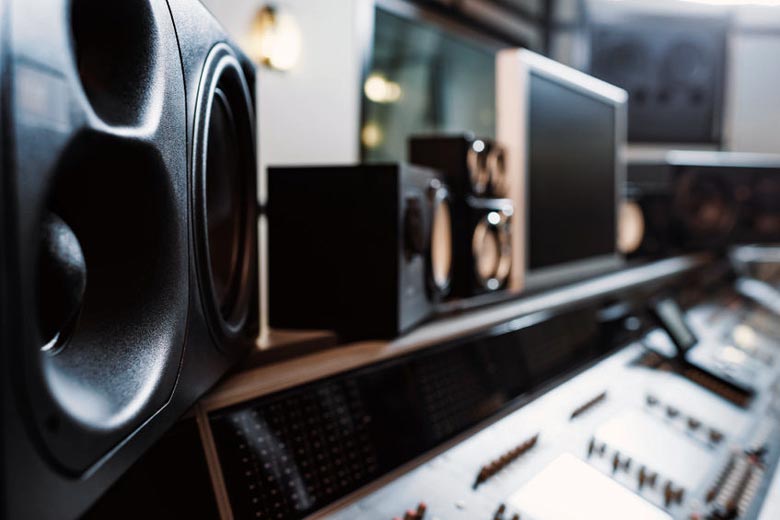Good music is vital for throwing a great party, whether at home or outdoors in a club or concert. Studio monitors are excellent for listening to well-contained and controlled music, as they provide accurate, detailed sound. Does that make studio monitors good for parties?
Studio monitors are good for small parties. Studio monitors hooked to a powerful amplifier can get loud without sacrificing audio quality. However, you may want to use a PA system to blast music at extreme volume levels for large parties.
This article will cover everything you should consider before using studio monitors for parties and why they might not be a good fit. I’ll also go over a few reasons why studio monitors may be better than traditional speakers in some cases.

Why Studio Monitors Can Be Great for Parties
Studio monitors aren’t designed for parties. However, they can still serve you well in the right conditions. Unlike home stereo systems and home speakers, studio monitors are designed for more than just listening to music.
Studio monitors are loudspeakers developed for precise and critical listening. They’re employed in studios for:
- Audio referencing
- Mixing
- Editing
- Mastering
- Producing
Unlike PA systems, studio monitors work best for near-field and mid-field listening.
This means the music sounds best when the listener is closer to the speakers, around 2 meters (6.56 ft) away. However, far-field studio monitors are also usually much larger, so you can hear them from across the room.
When listeners are too far, the audio quality will drop in terms of how well you can listen to the details in the music. This is because they’re designed for accuracy rather than sound enhancement.
However, people at your party probably care more about a good selection of music, not the sound quality and lack of distortion, so you’ll be good either way.
Instead, take some time to figure out what genres and artists are the most popular among your party guests.
What To Consider Before Using Studio Monitors for Parties
If you’re weighing out options on you should use studio monitors for your party, here are a few factors you should consider:
The Studio Monitor’s Cost and Intended Use
If you already have a pair of studio monitors at home or if you are planning on buying a pair for using them when mixing audio, it’d make sense to use them for a party.
However, I don’t recommend renting or buying studio monitors just for a party.
Studio monitors are far more expensive than conventional audio speakers. The extra expense is due to the high-quality components, the design and effort, and the precision manufacturing procedures used.
So if you’re using them only to listen to music for a party, it’d be a waste of money.
Additionally, they’re not as loud as other speakers because they’re made for short-range listening. This means they’ll only work for a small house party rather than at a club or gig.
Related article: Do Studio Monitors Have Bass? What You Need To Know!
Listening Field of the Monitor
Engineers describe studio speakers as near-field, mid-field, and far-field. This is the listening configuration for which a monitor is built. Depending on the number of people coming to your house party, you should use the kind of speakers that’ll serve you best, which really isn’t studio monitors.

But if you, for whatever reason, use studio monitors anyway, we recommend a far-field studio monitor so that people can listen to music from across the room. Especially for any party with more than five people.
As the name implies, far-field monitors optimize sound transmission over a greater distance. This is better for larger spaces with plenty of room for your guests.
Related article: Can Studio Monitors Be Used As PA Speakers?
Get a Subwoofer
If you want to host a house party with music to span the whole house, you can add a subwoofer to get a ton of bass. A subwoofer fills the room with bass, instantly improving the sound quality.
Parties are all about the listening experience. You can even rent a subwoofer if you don’t own one.
Suppose your monitors don’t have an obvious match. In that case, you’ll need to do some research to figure out what subwoofer would compliment them.
Cons of Using Studio Monitors for Parties
Studio monitors aren’t meant to be used as regular speakers or PA systems for parties, especially when the music needs to be extremely loud, like at a club. You risk your studio monitors overpowering and even tearing from the loud beats.
Even for a small house party, someone could easily knock over your expensive studio monitors or damage them while dancing to the music because one needs to be close to the studio monitors to really enjoy the music.
Studio monitors can also sound less enjoyable and, in some cases, more exhausting than typical hi-fi speakers, which have tonal balance to improve music for the average listener.
Why Studio Monitors Can Be Good For Parties
Even though you shouldn’t buy a pair of studio monitors just to use for parties, they can actually be quite good for smaller groups of people. It will most certainly do if you already have studio monitors at home and want to use them.
Here are a few reasons why they can be used at a party in a good way:
Studio Monitors Don’t Distort at High Volumes
One of the main disadvantages of cheap standard speakers is the severe distortion when you increase the volume past a certain extent. This is because their drivers and built-in amplifiers can’t handle the powerful signals that deliver high volumes. Often, the parts of these components can’t take power above a specific volume range, resulting in distortion.

Studio monitors have carefully designed drivers and amplifiers that can tolerate high-volume operations. Studio monitor amplifiers are typically built to match their drivers’ wattage and frequency ranges, reducing overloading during high-volume operation.
If your studio monitors get loud enough, they’ll be perfect for a small house party.
Most Studio Monitors Are Active
Most studio monitors have a speaker cabinet with an internal power amplifier that you’ll need to connect to a volume-controlling line source. That makes connecting a phone or other music source to the speakers is easy.
The active design makes them quite easy to move and to place in a position that fits the party. You don’t need a heavy and bulky amplifier to run the speakers, just plug them in and they’re ready to go.
Studio Monitors Have Quality Built-In Amplifiers
Cheap standard speakers are often more on-demand compared to studio monitors. This means manufacturers make cheaper amplifiers for traditional speakers that compromise quality, causing low dynamic ranges and narrow frequency responses.
Moreover, some don’t let off-the-shelf active speakers achieve high volume levels.
On the other hand, Studio monitors are built with high-quality amplifiers. Therefore, they produce better sound quality when blasting loud music, even though they aren’t usually made for too high a volume.
Studio Monitors Have a Better Dynamic Range
Studio monitors have a better dynamic range compared to standard speakers. Well-produced music sounds better because the studio monitor can handle dynamic fields better.
Usually, these factors aren’t something that matters for a party. People aren’t really listening to the music in that way, most just want to dance, have fun and talk to their friends.
Unless you have an audiophile party where you are critically listening to the music in silence, of course.
Conclusion
Although they’re suitable for listening to music, studio monitors aren’t a perfect fit for large parties. Standard speakers or a home theatre can be an excellent substitute because they’re designed for listening to loud music.
Even better, get a PA system for big parties. A PA system can handle loud music and be heard through spaces as large as a stadium.
